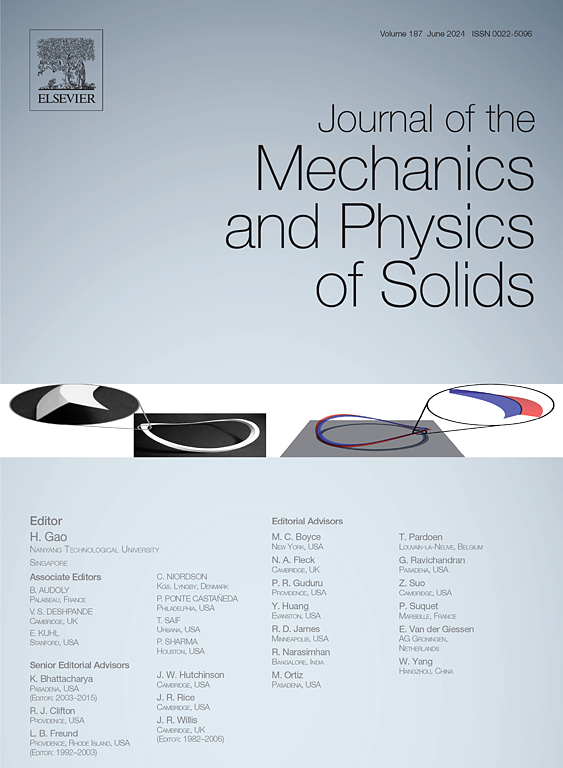A homogenization-based magneto-viscoelastic constitutive model for soft magnetorheological elastomers
IF 5
2区 工程技术
Q2 MATERIALS SCIENCE, MULTIDISCIPLINARY
引用次数: 0
Abstract
Soft magnetorheological elastomers (s-MREs) are a kind of smart composites composed of a mechanically soft viscoelastic matrix filled with soft magnetic particles. This work provides a standard two-potential framework for the constitutive model of s-MREs incorporating viscous dissipative mechanism, which rigorously adheres to the physical constrains imposed by even magneto-mechanical coupling, material frame indifference, material symmetry requirement and the second law of thermodynamics. Moreover, a numerical homogenization framework is developed to compute the macroscopic homogenized response of s-MREs. Based on the numerical homogenization results, an explicit free energy function and a dissipative potential that rely on the properties of the underlying microstructure are constructed. Only a small number of model parameters are calibrated by means of the numerically average magnetostriction responses under purely magnetic loading. The validity of the developed model is assessed by comparing the model predictions to the numerical homogenization results, under various matrix material parameters, magnetic loading rates and magneto-mechanical loading paths. The results demonstrate that the proposed model exhibits good agreement with the numerical homogenization results in all cases considered. Finally, the model is employed to solve for the magnetostriction of s-MRE specimens in the air medium. It is found that the simulation results are in excellent agreement with the experimental data reported in the literature. In addition, our research reveals that the proposed model provides a more profound insight into the underlying physical mechanisms behind the magnetostrictive behaviors of the s-MREs.
基于均质化的软磁流变弹性体磁粘弹性本构模型
软磁流变弹性体(s-MREs)是一种填充有软磁颗粒的机械软粘弹性基体构成的智能复合材料。本文为含粘性耗散机制的s-MREs本构模型提供了一个标准的双势框架,该框架严格遵守磁力均匀耦合、材料框架无关性、材料对称性要求和热力学第二定律所施加的物理约束。此外,还建立了计算s- mre宏观均匀化响应的数值框架。基于数值均匀化结果,构造了依赖于底层微观结构性质的显式自由能函数和耗散势。只有少数模型参数是用纯磁加载下的数值平均磁致伸缩响应来校准的。在不同的基体材料参数、磁加载速率和磁-力加载路径下,通过将模型预测结果与数值均质化结果进行比较,对所建立模型的有效性进行了评估。结果表明,在所有考虑的情况下,所提出的模型与数值均匀化结果吻合良好。最后,利用该模型求解了s-MRE试样在空气介质中的磁致伸缩问题。结果表明,模拟结果与文献报道的实验数据吻合良好。此外,我们的研究表明,所提出的模型为s-MREs磁致伸缩行为背后的潜在物理机制提供了更深刻的见解。
本文章由计算机程序翻译,如有差异,请以英文原文为准。
求助全文
约1分钟内获得全文
求助全文
来源期刊
CiteScore
9.80
自引率
9.40%
发文量
276
审稿时长
52 days
期刊介绍:
The aim of Journal of The Mechanics and Physics of Solids is to publish research of the highest quality and of lasting significance on the mechanics of solids. The scope is broad, from fundamental concepts in mechanics to the analysis of novel phenomena and applications. Solids are interpreted broadly to include both hard and soft materials as well as natural and synthetic structures. The approach can be theoretical, experimental or computational.This research activity sits within engineering science and the allied areas of applied mathematics, materials science, bio-mechanics, applied physics, and geophysics.
The Journal was founded in 1952 by Rodney Hill, who was its Editor-in-Chief until 1968. The topics of interest to the Journal evolve with developments in the subject but its basic ethos remains the same: to publish research of the highest quality relating to the mechanics of solids. Thus, emphasis is placed on the development of fundamental concepts of mechanics and novel applications of these concepts based on theoretical, experimental or computational approaches, drawing upon the various branches of engineering science and the allied areas within applied mathematics, materials science, structural engineering, applied physics, and geophysics.
The main purpose of the Journal is to foster scientific understanding of the processes of deformation and mechanical failure of all solid materials, both technological and natural, and the connections between these processes and their underlying physical mechanisms. In this sense, the content of the Journal should reflect the current state of the discipline in analysis, experimental observation, and numerical simulation. In the interest of achieving this goal, authors are encouraged to consider the significance of their contributions for the field of mechanics and the implications of their results, in addition to describing the details of their work.

 求助内容:
求助内容: 应助结果提醒方式:
应助结果提醒方式:


